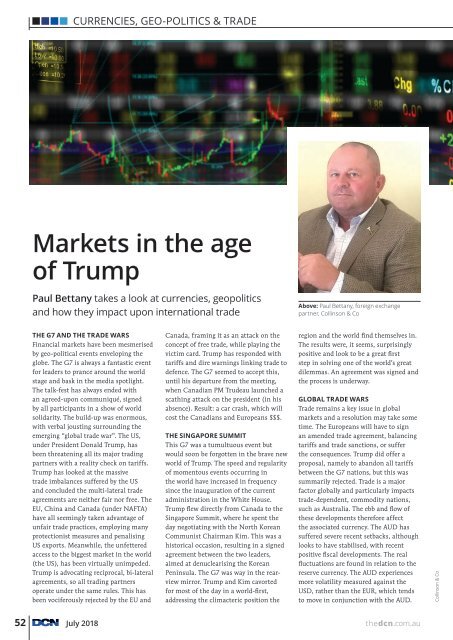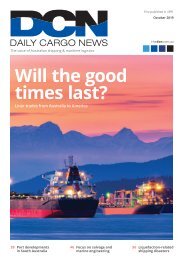DCN0718_Combined_150
Create successful ePaper yourself
Turn your PDF publications into a flip-book with our unique Google optimized e-Paper software.
CURRENCIES, GEO-POLITICS & TRADE<br />
Markets in the age<br />
of Trump<br />
Paul Bettany takes a look at currencies, geopolitics<br />
and how they impact upon international trade<br />
Above: Paul Bettany, foreign exchange<br />
partner, Collinson & Co<br />
THE G7 AND THE TRADE WARS<br />
Financial markets have been mesmerised<br />
by geo-political events enveloping the<br />
globe. The G7 is always a fantastic event<br />
for leaders to prance around the world<br />
stage and bask in the media spotlight.<br />
The talk-fest has always ended with<br />
an agreed-upon communiqué, signed<br />
by all participants in a show of world<br />
solidarity. The build-up was enormous,<br />
with verbal jousting surrounding the<br />
emerging “global trade war”. The US,<br />
under President Donald Trump, has<br />
been threatening all its major trading<br />
partners with a reality check on tariffs.<br />
Trump has looked at the massive<br />
trade imbalances suffered by the US<br />
and concluded the multi-lateral trade<br />
agreements are neither fair nor free. The<br />
EU, China and Canada (under NAFTA)<br />
have all seemingly taken advantage of<br />
unfair trade practices, employing many<br />
protectionist measures and penalising<br />
US exports. Meanwhile, the unfettered<br />
access to the biggest market in the world<br />
(the US), has been virtually unimpeded.<br />
Trump is advocating reciprocal, bi-lateral<br />
agreements, so all trading partners<br />
operate under the same rules. This has<br />
been vociferously rejected by the EU and<br />
Canada, framing it as an attack on the<br />
concept of free trade, while playing the<br />
victim card. Trump has responded with<br />
tariffs and dire warnings linking trade to<br />
defence. The G7 seemed to accept this,<br />
until his departure from the meeting,<br />
when Canadian PM Trudeau launched a<br />
scathing attack on the president (in his<br />
absence). Result: a car crash, which will<br />
cost the Canadians and Europeans $$$.<br />
THE SINGAPORE SUMMIT<br />
This G7 was a tumultuous event but<br />
would soon be forgotten in the brave new<br />
world of Trump. The speed and regularity<br />
of momentous events occurring in<br />
the world have increased in frequency<br />
since the inauguration of the current<br />
administration in the White House.<br />
Trump flew directly from Canada to the<br />
Singapore Summit, where he spent the<br />
day negotiating with the North Korean<br />
Communist Chairman Kim. This was a<br />
historical occasion, resulting in a signed<br />
agreement between the two leaders,<br />
aimed at denuclearising the Korean<br />
Peninsula. The G7 was way in the rearview<br />
mirror. Trump and Kim cavorted<br />
for most of the day in a world-first,<br />
addressing the climacteric position the<br />
region and the world find themselves in.<br />
The results were, it seems, surprisingly<br />
positive and look to be a great first<br />
step in solving one of the world’s great<br />
dilemmas. An agreement was signed and<br />
the process is underway.<br />
GLOBAL TRADE WARS<br />
Trade remains a key issue in global<br />
markets and a resolution may take some<br />
time. The Europeans will have to sign<br />
an amended trade agreement, balancing<br />
tariffs and trade sanctions, or suffer<br />
the consequences. Trump did offer a<br />
proposal, namely to abandon all tariffs<br />
between the G7 nations, but this was<br />
summarily rejected. Trade is a major<br />
factor globally and particularly impacts<br />
trade-dependent, commodity nations,<br />
such as Australia. The ebb and flow of<br />
these developments therefore affect<br />
the associated currency. The AUD has<br />
suffered severe recent setbacks, although<br />
looks to have stabilised, with recent<br />
positive fiscal developments. The real<br />
fluctuations are found in relation to the<br />
reserve currency. The AUD experiences<br />
more volatility measured against the<br />
USD, rather than the EUR, which tends<br />
to move in conjunction with the AUD.<br />
Collinson & Co<br />
52<br />
First published in 1891<br />
July 2018<br />
thedcn.com.au

















